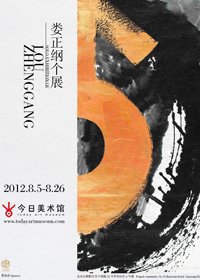Two exhibitions
dal 5/8/2012 al 3/9/2012
Segnalato da
5/8/2012
Two exhibitions
Today Art Museum, Beijing
Lou Zhenggang's calligraphic works and paintings showed the contemporary spirit of China, she was considered as a legendary figure during 1970s & 1980s. New installations and many representative works will be on exhibition now. Liu Yonggang called his abstract oil paintings created in recent years "line and phenomenon".

Line and Phenomenon
Yonggang Liu's Painting
Curator Yin Shuangxi
earing one stroke painting theory in mind, paint following the heart
——observations on Liu Yonggang’s calligraphic oil painting
Dr Liu Xiaochun
Liu Yonggang called his abstract oil paintings created in recent years “line and phenomenon”, and I am more accustomed to call them “calligraphy image”. The meanings of the two expressions are similar, both emphasizing the contextual relation between his abstract oil paintings and the meanings of line, calligraphy and writing in traditional Chinese writing.
The greatest difference between Liu Yonggang’s “line and phenomenon” and western calligraphy lies in the different understandings of calligraphy itself. As for its formal structure, the subject of the “line and phenomenon" art is one or more bold and rough brush strokes. Different from western artists, Liu Yonggang pursues implications expressed by the thick brush, nib-centered brush, stiff and exposed strokes, as well as plot twists and sneaking around in the process of his ingenious handling of the brushes, namely more internal and essential calligraphic implications. This differs greatly from the western style which uses one big stroke or abstract stipple. Therefore there is a big distance between Liu Yonggang’s “line and phenomenon” and western calligraphy in the forms and cultures behind them. Compared with Liu Yonggang, the western “calligraphy abstract” has less calligraphic significance.
The developmental process of calligraphy, is the process in which the significance of the calligraphy is more and more evident while the meaning of the context becomes more and more reclusive. The excessive prosperity of the Free Cursive is a turning point; the personalized “Calligraphy Revival” of the Qing Dynasty is another turning point; the modern calligraphy since the reform and opening –up is the third turning point. Liu Yonggang seized this historic turning point, and elaborated on the significance of calligraphy, ousting the meaning of context. His work seems to have no contextual content. Compared with the branch of modern calligraphy known as “art calligraphy”, Liu Yonggang’s personality is stronger and more powerful.
Liu Yonggang studies oil paintings art instead of Chinese ink paintings art. In painting, it seems that the feelings of brush, ink and paper are not real, but paradoxical. His grand strokes crossing the image are both writing and oil painting. Once the basis of line and phenomenon is finished, the stout brushwork is no longer “writing” but has become “form", Liu Yonggang changes writing to the art. He began to match the magnificent main melody with light and complicated minor chords, where the minor strokes are associated with the major ones, seeming to have the feeling of ink spluttering, but a symphony structure consisting of palette knives, brushes and paintings is formed.
----
Lou Zhenggang
Discovery
Lou Zhenggang started to learn calligraphy and painting from her father at her early age. She, as a young girl, was considered as a legendary figure in China’s calligraphy & painting filed during 1970s & 1980s. Lou Zhenggang went to Japan in 1986 and resided abroad from then on. She has been an active international figure of fine art for her devotion to spread Chinese culture. During the past 20 years, she staged 26 solo exhibitions and 3 tour exhibitions in China, Japan, USA and soon. Her calligraphic works and paintings showed the contemporary spirit of China, and collected by many renowned museums and private collectors. In 1993, Lou Zhenggang Works Exhibitions was held in UN headquarter in New York. The UN Children’s Fund printed 22 of her works onto postcards to issue in over 140 countries and regions. 8 of her works were chosen to be the cover page of 8-volume High School national language textbooks of Japan. In 2007, the 34 serial works named Life & Love by Lou Zhenggang was collected by China National Museum.
"My work is all I have got”. Art meant life to her during the past dozens of years. She constantly pursued something above and beyond in her artistic career by exploring more depictive new materials and by employing different media and tools. Her works included Life & Love, Sun and Moon Shining Forever, Heart, Harmony; Life Goes On, Nature and other serial works. Since 2004, Lou Zhenggang has gone out of art world to host interviews in Tokyo TV station, write columns for CEO Daily of Sankei Shimbun, etc. Her efforts on the promotion of Chinese calligraphy and painting culture have gained high acclaims. Her publications include ‘Heart’, ‘Words from Heart’, ‘Hindrance in Heart’, ‘Book of Heart’, and ‘Some Words to Give You’, ‘Maxim’ etc. Her new book, ‘Stories from Heart’ will be published by Sanlian Press in June.
Her new installations and many representative works will be on exhibition in Today Art Museum this time.
Publicity Department Tel:8610-58769690 Fax:8610-58769690 E-mail:pub@todayartmuseum.org
Today Art Museum
2nd Floor, Building No.1 No. 32 Baiziwan Road Chaoyang Dst, Beijing, China
Opening Hours: Building 1:10:00 am - 20:00 pm; Building2,3:10:00 am - 17:00 pm Free
Open Days: The first Saturday of each month; May 18th (International Museum Day )



